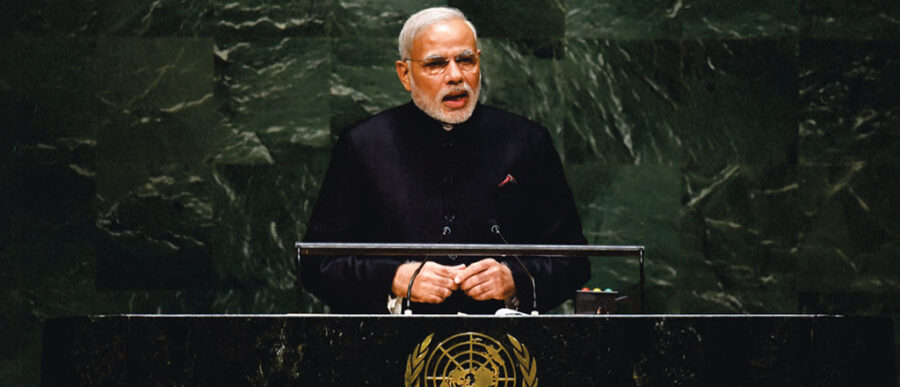As Indian Prime Minister Narendra Modi’s U.S. visit comes to an end, he carries back promises of renewed partnerships between the two countries’ governments and businesses. In what has been billed as a “rock star-like” tour, Modi packed 36 events into five days, including meetings with some 300 business executives, and talks at the United Nations, Madison Square Garden and Central Park in New York City. He managed all that while observing a nine-day fast (drinking only lemon juice and water) to mark the Hindu Navratri festival that is underway.
Unlike many other high-profile foreign jaunts by heads of state, Modi’s visit did not result in a long list of specific investment commitments from U.S. companies, partnership announcements or other business deals. But Modi used his trip to showcase India as an investment destination, and as a market for U.S. companies to sell into, according to Wharton marketing professor Jagmohan Raju and Devesh Kapur, director of Penn’s Center for the Advanced Study of India (CASI). The two discussed the takeaways from Modi’s visit on the Knowledge at Wharton show on Wharton Business Radio on SiriusXM channel 111. (Listen to the podcast at the top of this page.)
Kapur said Modi’s visit is significant because Asia will play a key role in the global economy in the 21st century; India will be a big part of that growth story, along with China. He also noted that U.S.-India trade is now worth about $100 billion and could grow “multiple-fold” over the next 20 years. Raju added that India has a large consumer market, which makes it more important as a business investment destination. “History has taught us that power goes wherever the buying power goes,”he said. “The buying power is likely to shift to India.”
Kapur noted that Modi sought to put to rest apprehensions and concerns that U.S. firms may have had about India’s stance on intellectual property rights and its tax regime. He also pointed out that even as the business community is enthusiastic about Modi’s plans, the Prime Minister will face an uphill road as India has to “reinvigorate its public institutions”and faces “severe challenges” in human capital. Raju “agreed to disagree,” saying that Kapur had underestimated Modi’s leadership potential. “As business people, we know how much difference a leader can make, and has made, in countries across the world,” Raju said.
Sizing up the gains of Modi’s visit, Raju noted, “There are country level agreements and business level agreements —[Modi] is trying to do both.” That said, he added that“much of the value of the visit will come from the business side, and Mr. Modi is making sure that that happens.” Kapur added that a key objective of Modi’s visit was to rebuild trust, especially as the relationship between the two countries has weakened somewhat in recent years.
“History has taught us that power goes wherever the buying power goes. The buying power is likely to shift to India.” –Jagmohan Raju
Modi began the business leg of his visit on Monday, at a breakfast meeting he hosted for 11 CEOs. At that meeting, he promised a more welcoming business environment in India, and identified infrastructure, skills development and tourism as areas in which he would like them to invest. The CEOs at that meeting included Google chairman Eric Schmidt, Citigroup CEO Michael Corbat, PepsiCo CEO Indra Nooyi, MasterCard CEO Ajay Banga, Warburg Pincus co-CEO Charles Kaye and Merck chairman and CEO Kenneth Frazier. Modi later had one-on-one meetings with the CEOs of General Electric, IBM, Goldman Sachs, Boeing, BlackRock and KKR.
Ahead of the Modi visit, media outlets reported that U.S. companies were eyeing $3.5 billion worth of defense and aerospace deals in India, and that firms including Google, IBM and Adobe had expressed interest in Modi’s plans for smart cities and a “Digital India”program with an outlay of Rs. 100,000 crores (approximately $17 billion) over the next five years. Among other objectives, the Digital India program aims to bring high speed Internet connectivity to all of India’s 600,000 villages.
Mixed Results
Modi drew a mixed response in his overtures to U.S. business. Caterpillar CEO Doug Oberhelman, who attended the Monday breakfast meeting with Modi, told Reuters that he was “genuinely quite impressed.” But the Reuters report also said Modi “alarmed some foes of government tinkering with business last week when he said in India, multinational soft drink giants PepsiCo Inc. and Coca-Cola Co. should help increase sales by Indian farmers by adding fresh fruit juices to their fizzy drinks.” Business groups have highlighted India’s trade barriers and its opposition to the World Trade Organization’s agreement on climate change as other concerns that could be an impediment to making investments there.
Modi also scored what The Washington Post called “a rare second day of attention”from President Barack Obama, highlighting the White House’s desire “to give a warm welcome to a man who was once barred from even entering the U.S.” Modi was denied a U.S. visa following widespread criticism over his handling of communal riots in the state of Gujarat in 2002 when he was its chief minister. Some 800 Muslims and 250 Hindus were killed in the riots, according to official records.
“There are country level agreements and business level agreements —[Modi] is trying to do both.” –Jagmohan Raju
In a joint op-ed published in The Washington Post on Tuesday, Obama and Modi wrote, “The true potential of our relationship has yet to be fully realized. The advent of a new government in India is a natural opportunity to broaden and deepen our relationship.” They added: “While India benefits from the growth generated by U.S. investment and technical partnerships, the United States benefits from a stronger, more prosperous India.”
The two leaders also spoke of collaboration in clean energy, climate change, medicine and efforts to improve sanitation and hygiene in India. They signed off the op-ed with“Forward together we go —chalein saath saath [meaning: “We will walk together” in Hindi].”



